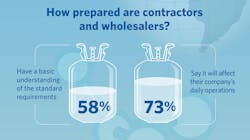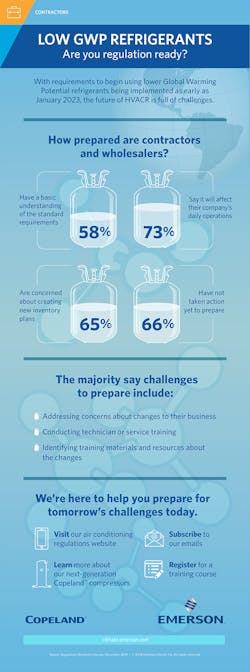Refrigerant Transitions: Are You Regulation Ready?
Once again, the HVACR industry is facing a phasedown of a favorite refrigerant. This time, it’s R-410A. HVACR contractors and wholesalers are not fully prepared for the change, and they have many questions. Thankfully, there's still some time, but it is always fleeting.
R-410A is scheduled for elimination from new systems in 2023, there are a few hurdles to leap related to legislation, mildly flammable replacements and building codes. One of our favorite industry colleagues, Emerson’s Becky Hoelscher, provides this update.
Contracting Business: We hear the date for the phasing out of R-410 from new HVACR systems is not settled, and that January 2023 is an approximation. Why is this the case?
Becky Hoelscher, Director of Aftermarket Sales, Emerson: The effort to phase down HFCs on a global level is being driven by the Kigali amendment. Unlike the transition from ozone depleting substances (R-22) in which the Montreal protocol called for a phase out, the Kigali amendment calls for a phase down in prescriptive steps. The U.S. has yet to ratify the Kigali amendment, but there is effort underway at the federal level to pass legislation to phase down the use of HFCs through the AIM Act. In the meantime, California has proposed regulation at the state level that would prohibit the use of refrigerants greater than 750 GWMany organizations, including Emerson, are working diligently to educate and train contractors and wholesalers on the safe handling of flammable refrigerants.
CB: How can HVACR contractors and their wholesalers move beyond a “basic understanding” of the requirements ?
BH: The refrigerant transition is complicated by the fact that it is occurring on a state-by-state basis. The timing and requirements may not be consistent from state to state, leading to extra complexity and confusion. A federal transition is desired to reduce the complexity by setting forth one set of rules for the entire country. Many organizations, including Emerson, are working diligently to educate and train contractors and wholesalers on the safe handling of flammable refrigerants. AHRI is actively developing educational materials regarding the transition to next generation refrigerants as part of the Safe Refrigerant Transition Task Force, ACCA is currently in the process of developing training and guidelines for the safe handling of mildly flammable A2L refrigerants and NATE is updating their certification to include service training.
CB: In what ways did both groups specify how the phaseout will affect daily operations?
BH: Our recent survey found that training service people and technicians is both a top concern and top priority. We’ve received feedback that daily operations could potentially be affected the following ways: equipment designed for A2L refrigerants will likely have new embedded sensors and controls; there will need to be management of proliferation of refrigerant options; there will be a need to comply with storage and transportation requirements of refrigerant, systems and components; and there will be a need to ensure the safety of the employees handling the refrigerants (service and install) along with potentially having to provide an explanation of the system changes to the end users.
CB: In relation to contractors creating new inventory plans, why is this not as simple as recovering and recycling, and making sure they have enough R410A on hand for service needs?
BH: Refrigerant transitions historically have led to an increased push for replacement ahead of the transition and an increased replacement market post transition. This can be caused by increased cost of systems and the unknowns of the new refrigerant, in this case likely one that is mildly flammable (potential training, handling and storage concerns). There also will likely be two refrigerants replacing R-410A: R-32 and R-454B. This could cause distributors/wholesalers to specify certain brands based on which refrigerant they prefer. In some states, we might see a requirement for the use of reclaim refrigerant for service.
To date, only non-toxic, non-flammable refrigerants have been permitted in high probability, direct expansion (DX) systems for both residential and commercial use. Product safety and application standards have been developed for the safe use of these newer mildly flammable refrigerants, but model and building codes need to be modified to permit their use.
CB: What is the status of building code modifications, which will be required to use a mildly flammable refrigerant?
BH: The modification of building codes to enable the use of the next generation of mildly flammable refrigerants is underway. To date, only non-toxic, non-flammable refrigerants have been permitted in high probability, direct expansion (DX) systems for both residential and commercial use. Product safety and application standards have been developed for the safe use of these newer mildly flammable refrigerants, but model and building codes need to be modified to permit their use. There was an effort to modify the model codes (ICC and IAPMO) during the 2021 code cycle; however, the publication of the safety standards did not occur with enough time for all stakeholders to review and evaluate the limitations and safety mitigations required. As result, the proposal to add mildly flammable refrigerants into the model codes was voted down and is now being considered for the 2024 code cycle. At the state level, Washington has adopted UL 60335-2-40 3rd edition and ASHRAE 15 2019 edition into their state building codes. These are the revised safety standards that address the use of A2L fluids in new equipment. Additional states may be looking to Washington as an example, or they could follow the more traditional approach of waiting for the model codes to be updated and then adopting those into their state and local codes.
CB: Who are contractors’ and wholesalers best resources for information, including training?
BH: Industry organizations provide a number of resources to help contractors and distributors navigate these changes, including AHRI, ACCA and NATE. AHRI organized the Safe Refrigerant Transition Task Force to evaluate the safe commercialization of low-GWP refrigerants and share learnings with the industry. ACCA also provides its members with information and updates on both efficiency and refrigerants regulations. From a training standpoint, it is imperative for technicians to prepare with NATE training and certification so they can install and service systems that meet new efficiency and refrigerant regulations with confidence.

